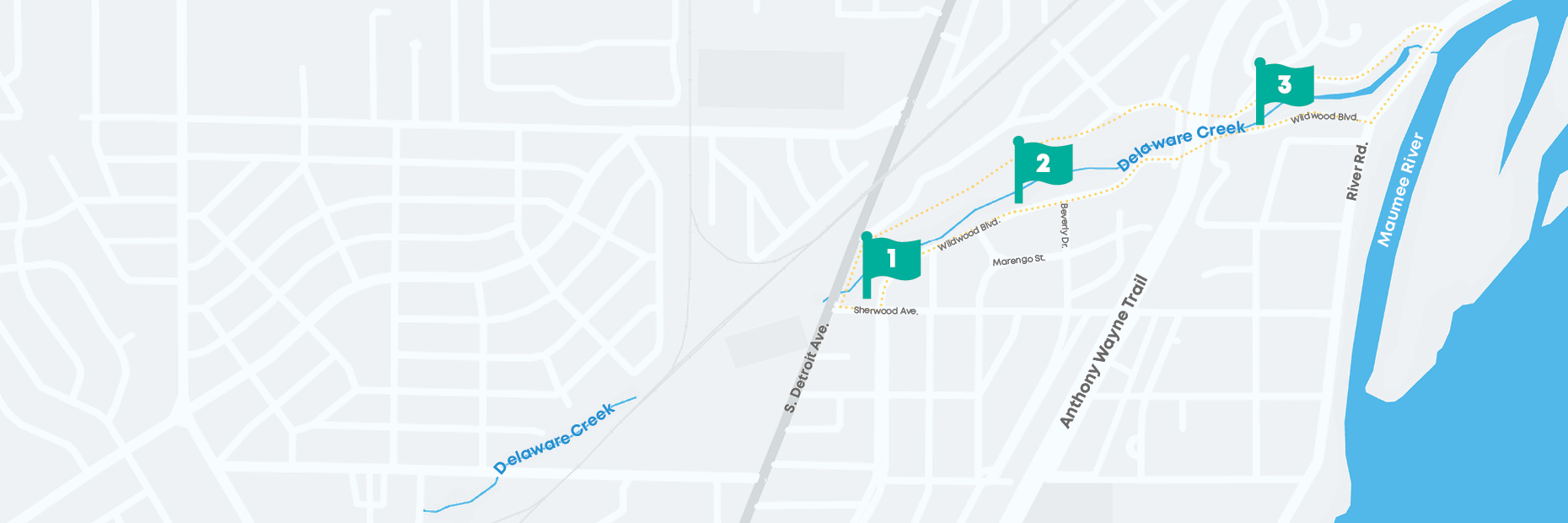Phase II
The City of Toledo aims to continue the work in Delaware Creek to prevent scour and erosion on the hillside and streambank caused by large amounts of water while also improving the benthic (bug) communities and fish habitat in the downstream area.
We will fix the erosion problem caused by the high flow and velocity of storm water runoff entering the area from an outfall that drains the Anthony Wayne Trail.
What we're doing:
- strengthening the stream bank against further erosion
- improving water quality and restore habitat in the main channel of Delaware Creek
- stabilizing the stream bank
- installing structures to improve habitat
- seeding native plants
This project is funded by a Great Lakes Restoration Initiative grant for $500,000. Construction is scheduled to take place in 2025.
Phase I
Rain gardens and bioswales, completed in 2020, work to fix erosion problems, reduce runoff, and improve water quality and habitat. Delaware Creek is a 1.8-mile stream that drains five square miles. It enters the Maumee River at river mile 9.2.

West Rain Garden
8,280-square-foot rain garden and bioswale at Wildwood Blvd. and Sherwood Ave.
Terraced Rain Garden
600-square-foot tiered rain garden along a highly eroded streambank on Wildwood Blvd. between Marengo St. and Beverly Dr.
East Rain Garden
2,540-square-foot rain garden and bioswale at the end of Wildwood Blvd. off River Rd.
About the Project
This project was financed in part through a grant from the Ohio Lake Erie Commission and the United States Environmental Protection Agency (U.S. EPA) with Great Lakes Restoration Initiative funds. The contents and views, including any opinion, findings, or conclusions or recommendations contained in this product or publication are those of the authors and have not been subject to any Ohio Lake Erie Commission or U.S. EPA peer or administrative review and may not necessarily reflect the views of the Ohio Lake Erie Commission or the U.S. EPA and no official endorsement should be inferred.
Improving Water Quality
These improvements will help restore habitat and water quality in Delaware Creek, a tributary of the Maumee River in the Lake Erie basin. Projects will help fix some erosion problems and will reduce sediment, nutrient, and chemical loading from stormwater into local waterways.
Prior to these improvements, Ohio EPA water quality sampling results in the creek show:
- Significant sedimentation/siltation
- Excessive nitrate/nitrite and phosphorus
- Elevated levels of pesticides, chloride and total dissolved solids
Ohio EPA biological sampling results in the creek show:
- Above target for fish communities
- Below target for invertebrate communities
- “Very poor” narrative score
- Estimated 20% of the target goal
- Below target for aquatic habitat quality
- 74% of the target goal
- Decreased 4.5 points between 2006 and 2017 Ohio EPA sampling events